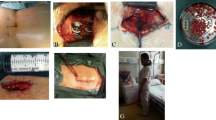Abstract
Lumbar spinal fusion is a commonly performed surgical procedure, yet both the indications for its performance and its results remain controversial. It is generally believed that apart from situations where obvious measurable instability exists, a repeat surgical procedure such as spinal fusion does not improve the functional outcome in more than an average of 50% of cases. The aim of this study was to analyse functional outcome after posterolateral lumbar or lumbosacral spinal fusion, comparing primary and salvage procedures. It was designed as a prospective case/referent study with a 2-year follow-up. A total of 39 patients underwent a short posterior fusion with Cotrel-Dubousset (CD) pedicle screw fixation after earlier surgery of the lumbar spine. Two patients were erroneously omitted from the study at the index, so 37 patients were included in the salvage group. In the same period, 69 patients underwent lumbar fusion with pedicle screw fixation (CD) as primary surgery (referent group). Functional outcome was assessed by means of the Dallas Pain Questionnaire preoperatively and 1 and 2 years postoperatively. Fusion rates were determined by ordinary X-ray evaluation by two independent observers. Patients who had undergone previous spinal surgery had a significant improvement in functional outcome in terms of daily activity, work and leisure-time activities and anxiety/depression. With regard to social functioning, a significantly inferior outcome was found after the salvage procedure. The return-to-work rates at 2 years after surgery were 50% in the salvage group and 53% in the referent group. There was a significant correlation between radiological evaluation of the fusion mass and the functional outcome. The fusion rate was 76% in the salvage group and 72% in the referent group. This study demonstrates that a posterolateral spinal fusion can be effectively used as a salvage procedure. The functional and radiological outcome of the patients with revision surgery did not differ from those of the group of patients who underwent primary surgery. There was, however a clear indication of inferior social functioning after revision surgery.
Similar content being viewed by others
Author information
Authors and Affiliations
Additional information
Received: 29 November 1997 Accepted: 22 January 1998
Rights and permissions
About this article
Cite this article
Christensen, F., Thomsen, K., Eiskjær, S. et al. Functional outcome after posterolateral spinal fusion using pedicle screws: comparison between primary and salvage procedure. E Spine J 7, 321–327 (1998). https://doi.org/10.1007/s005860050082
Issue Date:
DOI: https://doi.org/10.1007/s005860050082




